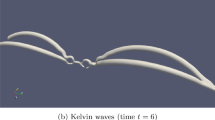Abstract
The dynamics of the structure of an infinite vortex tube in ideal gas under explosive external energy deposition near its axis is studied. With neglect of viscosity and heat conduction, it is discovered that the tube is destroyed under arbitrarily small power of energy release and the time of vortex destruction decreases as the total power of energy release increases. The physical model of the flow explaining the revealed relationships is constructed. The analytical relations assessing the problem parameters for the practical use of explosives in destruction of large-diameter vortices are obtained. The estimates show that the proposed method can be applied in practice.






Similar content being viewed by others
REFERENCES
F. H. Clauser, Adv. Appl. Mech. 4, 1 (1956).
S. S. Khmelevtsov, Appl. Opt. 12, 2421 (1973).
B. Feldman, US Pat. Appl. No. 20020088364A1 (2002).
R. H. Nelson, US Pat. Appl. No. 20100001118A1 (2010).
M. B. Gravina, US Pat. Appl. No. 20100276533A1 (2010).
H. Yi and J. Yi, US Pat. Appl. No. 20040149156A1 (2004).
A. M. Bissell, US Pat. Appl. No. 2015090805A1 (2015).
G. A. Simmons and G. L. Nelson, Proc. 29th AIAA Plasmadynamics and Lasers Conf., Albuquerque, United States,1998, p. AIAA-98-2752.
V. Yu. Kolosov, V. Yu. Sepman, V. S. Sukhomlinov, Yu. A. Tolmachev, A. L. Kuranov, V. V. Kuchinsky, V. A. Sheverev, and M. V. Otugen, Proc. 9th Int. Space Planes and Hypersonic Systems and Technologies Conf., Norfolk, United States,1999, p. AIAA-99–4882.
V. Yu. Golyatin, V. V. Kuchinskiy, and V. S. Sukhomlinov, Tech. Phys. 50, 582 (2005).
E. P. Gurijanov and P. T. Harsha, Proc. Space Plane and Hypersonic Systems and Technology Conf., Norfolk, United States,1996, p. AIAA-96–4609.
N. A. Gerasimov and V. S. Sukhomlinov, Tech. Phys. 55, 1553 (2010).
V. A. Sheverev, M. V. Otugen, and V. S. Sukhomlinov, Phys. Fluids 17, 1 (2005).
V. S. Sukhomlinov and A. S. Mustafaev, Tech. Phys. 61, 1328 (2016).
N. Gerasimov, V. A. Sheverev, and V. S. Sukhomlinov, J. Appl. Phys. 104, 043301 (2009).
N. A. Gerasimov, V. V. Kuchinskiy, V. S. Sukhomlinov, and S. V. Sukhomlinov, Tech. Phys. 52, 831 (2007).
E. N. Bondarev, V. T. Dubasov, and Yu. A. Ryzhov, Aerohydromechanics (Mashinostroenie, Moscow, 1993), p. 90.
Author information
Authors and Affiliations
Corresponding authors
Ethics declarations
The authors declare that there is no conflict of interest regarding the publication of this paper.
Additional information
Translated by E. Oborin
Appendices
APPENDIX A
We apply the Laplace transform in variable y to Eq. (6) with account for (7) and write for g(s, x)
The equation is obtained with account for zero initial conditions for the radial velocity and its time derivative. The solution to this equation for the region x < 1 bounded at x = 0 has form
where I1(x) and K1(x) are the modified Bessel and Hankel functions of the first kind, respectively. With limit process Δ → 0, we compute the inverse Laplace transform with account for the convolution theorem and obtain
We perform computations, pass to the limit y0 → 0, and derive formula (8). For the region x > 1 the solution to Eq. (A.1) bounded at x → ∞ has the form
From Eq. (A.2) at Δ → 0 the continuity of function g(s, x) at x = 1 leads to
It follows from this formula that relation (8) is satisfied for any value of coordinate x.
APPENDIX B
The third equation of system (5) and relation (8) imply that \({{{\bar {v}}}_{y}}\) = 0 if y < x for any value of variable x.
In the solution of the problem in the case y > x, we first consider the region x < 1. We introduce the new independent variables in the third equation of system (5),
y instead of variables x and y and function
and obtain equation
Solving it with initial conditions P(η, 0) = 0, we obtain
where β = \(\frac{{{{M}_{0}}{{\kappa }_{0}}{{Q}_{0}}}}{{2\pi }}\).
We transit to physical variables y and x and derive relation (9).
Now, we consider the region x > 1. We act as above and derive for the function
that
The boundary condition for this equation is the continuity of function \(\bar {P}\)(η, y) at y = y(η), where y(η) is the solution to equation
As a result, we obtain formulas (10). Note that Eq. (B.2) has the two real roots y1(η) and y2(η), for which the following asymptotics is valid:
We must choose them correctly in the substitution into Eq. (10). It is easy to show that, for any value of parameter β > 0, there is a value y = y∞ at which it is true that
and y1(η) = y2(η) = y∞. Then, for y < y∞ we should take y(η) = y1(η) and for y > y∞ we should take y(η) = y2(η). It is easy to show that the following asymptotics is valid
Thus, the algorithm for calculating at x > 1 consists in the following. For a given value of β we numerically solve Eq. (B.3) and determine y∞. If time y at which the calculation needs to be performed is smaller than this value, then in the numerical solution of Eq. (B.3) we must take the first relation of Eq. (B.4) as an initial guess. If it is larger, then we must take the second relation.
Rights and permissions
About this article
Cite this article
Sukhomlinov, V.S., Mustafaev, A.S., Strakhova, A.A. et al. Destruction of a Stationary Vortex in an Elastic Medium by Energy Deposition. Tech. Phys. 65, 548–554 (2020). https://doi.org/10.1134/S1063784220040210
Received:
Revised:
Accepted:
Published:
Issue Date:
DOI: https://doi.org/10.1134/S1063784220040210



